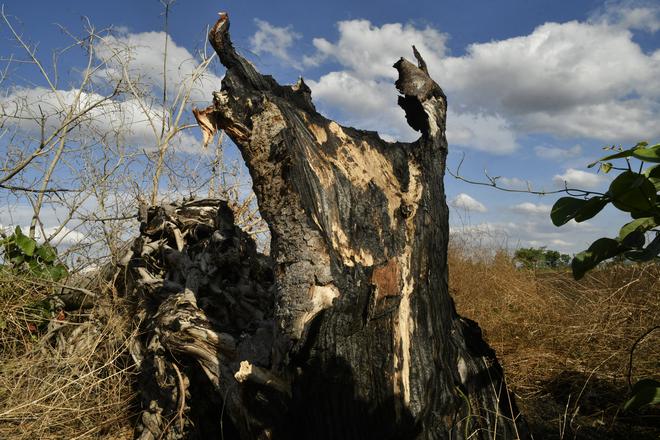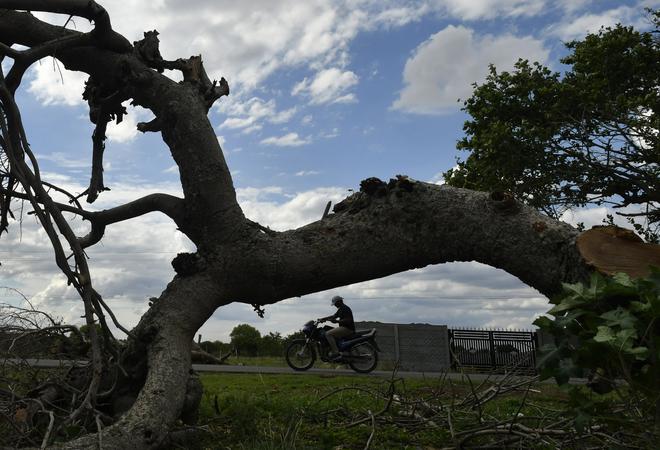The 474-km road twists, winds, and curls along as the rubber burns the asphalt. Luxury cars swerve to a side when another vehicle manifests at an unexpected curve on the two-lane route which is — hard to believe — a national highway (NH).
Ficus, mostly banyan (Ficus Benghalensis) and cluster fig (Ficus Racemosa) of all sizes and shapes stand on both sides of the NH-163 between Moinabad of Rangareddy district and Manneguda of Vikarabad district, via Chevella, in Telangana.
The road leads to the village Ravulapally in Ranga Reddy district on one side and to Bhoopalapatnam road in Chhattisgarh on the other.
Many of the trees are stunted owing in part to decades of exposure to traffic, pollution, and other environmental disturbances. A few are fully developed, their prop roots forming miniature ecosystems.
In 2017, the National Highways Authority of India (NHAI) decided to expand the road. Over 900 of these trees, famously known as the Chevella banyans were to be cut. Then a group of tree lovers from Hyderabad got involved leading to the National Green Tribunal’s directions to the NHAI in November this year to commission an environmental impact assessment (EIA).
The NHAI is not statutorily obligated to commission the study for road expansion projects, unless the road length is more than 99 kilometres.
“To circumvent the provision in case of major expansion, the Central government agency has devised a way to segment the project into pieces less than 100 km, and award the contracts phase-wise,” says Pranay Juvvadi, an ecologist and independent researcher, who is also a petitioner to the NGT.
Citizen activism
It had all started with an online petition on the Change.org website to protect the banyans, which were to be axed for road expansion.
“I started the petition in 2019 after coming to know that approval had been given for felling of trees on both sides of the highway,” recalls P. Uday Krishna, founder of Vata Foundation, a not-for-profit that protects fully grown trees and helps in translocation of trees legally marked for felling.
By the time Uday Krishna noticed, the trees on NH-163 between Manneguda and Ravulapally, most 80 to 100 years old, had been axed. The 46-km stretch between Moinabad and Manneguda alone still had the trees.
The banyans and other Ficus were planted on this stretch during the reign of Mir Osman Ali Khan, the last Nizam of Hyderabad State before it was merged with the Indian Union.
The banyan is India’s national tree, and is called a keystone species by virtue of fostering growth of a wide variety of wildlife including birds, bats, insects, and rodents.
“They provide food to several species of fauna even in extremely trying climate conditions. According to scientific estimates, 1,200 species of fauna the world over depend on Ficus, which is a survival specialist and needs limited soil and water. The advantage with banyan, among various Ficus varieties, is that it survives for ages through its prop roots, even after the main trunk dies,” says N. Chandramohan Reddy, a botanist and retired forester.
More than a tree
Ficus also has cultural significance in Telangana, and is considered a symbol of fertility. Parts of the tree are used in preparation of Ayurvedic medicine. Uday Krishna says he has an emotional attachment with the banyan tree, as his family was involved in the preparation of a traditional medicine using its sap. He named the foundation ‘Vata’ after the banyan.
As a solution to the banyan conundrum, Vata Foundation proposed translocation of the trees to the side of the widened road. An appeal was made to citizens across the country, and it received support with 35,296 signatures. The petition stirred into action a few members of an eclectic social media group called Nature Lovers of Hyderabad who formed a coalition with the name ‘Save the Banyans of Chevella’. They started another online petition on the same platform to save the banyans in situ (in the same place).
The petition addressed to Telangana Chief Minister of K. Chandrasekhar Rao, Ministers K.T. Rama Rao, A. Indrakaran Reddy, the then principal chief conservator of forests P.K. Jha, and Union Minister of Road Transport, Highways, and Shipping Nitin Gadkari demanded that the trees be retained as medians with expansion on either side.
Where not feasible, the trees on one side could be retained and the road widened on the other, they proposed. Translocation is not an option for large, mature trees because of poor chances of survival, the petition contended.
Citizens’ movements for tree and environment protection, though confined to Hyderabad city and limited elite groups, have had a high success rate in Telangana. Nearly eight years ago, the State government’s proposal to cut down over 3,200 trees of the Kasu Brahmananda Reddy National Park — a verdant forest island in the thick of Hyderabad city traffic — to facilitate road infrastructure, met with protests from walker groups and concerned citizens. A prolonged legal battle has forced the State to shelve the project for all practical purposes.
Similarly, the movement to protect the 180-acre prehistoric rock formations at Khajaguda on the western part of the city has been able to thwart attempts to encroach upon the site multiple times.
With the Chevella Banyans too, public pressure had its effect on the Forest department which withdrew the permission it had granted for felling the trees, halting the project.
Multiple threats
The whole issue erupted once again in June 2020, in the midst of the COVID-19 pandemic, when Uday Krishna noticed that a large number of the banyans were burnt at their base. A few trees had been hacked down. No conclusive proof was available on the perpetrators of this extreme action. Members from the ‘Nature Lovers of Hyderabad’ group prepared a data sheet, according to which a total 101 trees were burnt or damaged, some of them severely. The group also geo-tagged all the trees, and published it online.

In December 2020, Union Minister Gadkari dedicated to the nation six highway projects in Telangana, including four-laning of the 99-km Yadgiri-Warangal section of NH-163 under the National Highways Development Project (NHDP), and widening of the 72.53-km Manneguda-Ravulapally section of NH-163.
This has increased pressure on NHAI for completion of the remaining portion of the highway. Another application was sent to the Forest department for clearing the trees between Moinabad and Manneguda. Bids were called for, and evaluation was under way in 2021, when three members of the citizens’ group — Tejah Balantrapu, Natasha Ramarathnam, and Juvvadi — approached the NGT seeking intervention.
As the ecological impact of felling trees is irreversible and the proposed widening is not in line with the precautionary principles, the petitioners, who went to the NGT, sought direction to the NHAI to obtain environmental clearance before proceeding with the project.
According to NHAI’s submission to the court, the road from Hyderabad to Manneguda is the most accident prone, due to heavy vehicular traffic. It placed the accident figure on this stretch at 240 during 2021. The existing 7-metre road had crossed its threshold capacity of 10,000 passenger car units eight years ago. It further increased to 14,470 in 2020, which is 45% in excess of the threshold limit.
The NHAI put the number of banyans at 759 on the stretch, though the petition had the number at 1,036. NHAI assured relocation of the trees as much as possible, besides planting of 53,000 trees on the stretch. In addition, it offered to lay the highway in an eccentric manner rather than concentric, which meant that the expansion would be done towards one side, protect the trees on the other side. Further, the NHAI also expressed willingness to translocate the trees marked for removal.
NGT intervenes
After hearing both the sides, the NGT appointed an expert committee to explore the possibility of an alternative route while protecting the banyans in situ. The committee, during field inspection, counted a total 915 banyan trees, 759 of them in non-forest area and 156 in the forest area. Eccentric widening, bypasses, and realignment would save 232 trees, while the rest could be translocated, it said.
In its final order, the court observed that the existence of so many banyan trees on a single stretch, along with several thousands of other trees, was a rare phenomenon. Hence, an EIA should be conducted before going ahead with the project. The order was not favourable to translocation, and raised doubts about the financial burden and survival of the trees.
The petitioners were elated at the verdict, and called it a landmark judgment.

As per the initial notification of the rules pertaining to the Environment Protection Act, 1986, for any highway project exceeding 30 km, an EIA was mandatory. Through an amendment in 2006, the Act changed the length to 99 kilometres.
The judgment has set a precedent by ordering an EIA for A distance less than what is prescribed, says Juvvadi. He looks forward to the public hearing, a part of the EIA process, where people can record objections.
“There is no guarantee that a straight, expanded highway proposed by NHAI would be accident-free,” Balantrapu, another petitioner, and a communications professional, says, citing the example of the Nagpur-Mumbai expressway where, according to news reports, 1,282 accidents took place over nine months, killing 135.
Some reservations
There are others who are sceptical about the judgment. “This order is not a win for the environment by any measure. We have a history of how EIAs are manipulated to suit the interests of project proponents. And when public hearing is conducted, residents of the surrounding villages might vote en masse for felling of the trees,” says K. Baburao, a scientist and environmentalist, retired from the Indian Institute of Chemical Technology.
Uday Krishna, who started the initial petition for saving the banyans, is not elated either. “Unfortunately the judgment is not encouraging. There is no clear order to save the banyans in situ. Nor has the NGT directed NHAI to divert NH-163. The remaining banyans are in more danger than before. NGT has left the fate of these trees to NHAI and the Ministry of Environment and Forests,” he despairs. In fact, government departments could use this judgment as precedent to fell trees after conducting EIA, he feels.







